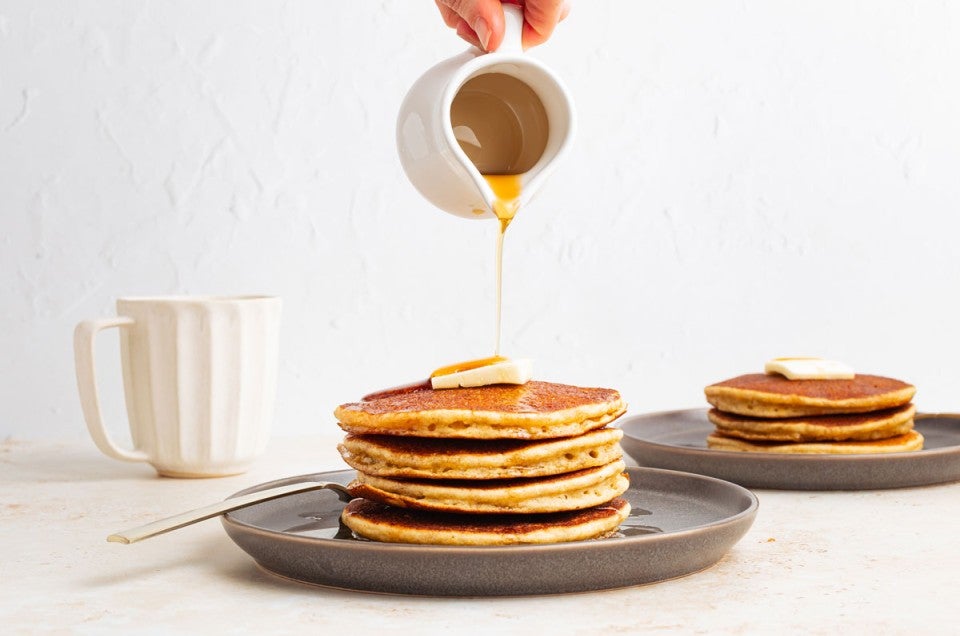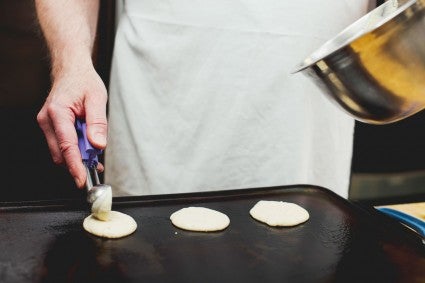I've baked over 18,000 pancakes. Here's how to make your best.
From preparing toppings to greasing your griddle, these are my top tips.


Frank Tegethoff is a veteran member of King Arthur’s research and development team. In addition to ensuring we sell the highest quality flour possible, he also helps create our many products and baking mixes.
* * *
After a lifetime of making pancakes for family and friends — and working too many buffet stations to count — I thought I was ready when the R&D team was asked to work on our new line of pancake mixes. But even with all that experience, my team and I still found ourselves spending months in the test kitchen, making pancakes every single day to perfect each of the mixes that went into the line.
Not only did we end up tasting a couple of hundred versions as we worked to finalize the flavors and texture of each mix, but we also discovered some great tips and shortcuts for making perfect pancakes along the way. So when Saturday morning comes around or an insatiable pancake craving strikes, here are some of my best tips that will make every pancake occasion even better and easier.
Fresh pancakes are the best pancakes. Make sure you don’t lose a moment of that freshness by preparing all your toppings at the beginning: the butter should be softened, the syrup (or other sauces like caramel or chocolate) already warmed, the cream whipped, the berries at room temperature, etc. These toppings should all be waiting for the arrival of the pancakes — not the other way around.

Always whisk the liquid ingredients together first, until you see bubbles begin to form. Then add the dry ingredients. This does a few important things: It emulsifies the fat and water in the batter, and it reduces over-mixing. Adding the dry ingredients on top of the wet also prevents the common issue of dry ingredients sticking to the bottom of the bowl.

A brief rest allows the leaveners in the batter to be almost fully activated when they hit the hot griddle, which will yield the tallest and lightest pancakes possible. The directions on our pancake mixes tell bakers to let the batter sit for at least 5 minutes; in that time, you’ll notice the batter thicken. You'll know when it's ready because the batter gives a little jiggle if you tap the mixing bowl, instead of looking thin like water.
It’s important to understand that, despite their name, nonstick griddles also need oil to completely avoid any sticking. Apply the oil to the preheated griddle right before you drop the batter onto it. As I like to say, “Hot pan, cold oil, food won’t stick.” And be ready to reapply a light coating of oil between pancakes.

A cookie scoop is much better than a measuring cup for dropping the batter. It ensures that each pancake will be a uniform size, which takes a lot of the guesswork out of judging when to flip each one. (A muffin scoop also works for larger pancakes.)

When the batter hits the hot griddle, the pancake rises and the structure of tiny bubbles sets. When you flip, the semi-fluid batter on the other side repeats the process. Have patience here — flipping early is not your friend, because you want to ensure the pancake fully rises and the structure has time to set. When you flip, the edges should be just taking on a matte appearance and the top should show broken bubbles. The pancake should be about two-thirds done cooking by the time you flip.
Thinner pancakes will stay more moist and tender if cooked a little more quickly, so turn up the heat a bit when cooking.

Remove pancakes to a wire rack, spaced out individually or lined up in an overlapping row “shingle-style” if you have a lot of pancakes. Place them in a low oven (about 150°F) covered with a clean towel while you wait to serve them. Spacing them out on a rack, rather than piled on top of each other in a classic stack, provides just enough air circulation to prevent them from sticking together and becoming gummy.
Pancakes (and waffles) freeze very well. Always allow the pancakes to cool completely, then place a square of parchment paper between each of the individual cakes when they go into the freezer. This keeps the pancakes from solidifying into a single frozen blob.
To put these tips to the test, try one of our many pancake recipes or our newest pancake mixes for breakfast.
Cover photo by Mary Lagier.


July 5, 2024 at 11:39am
My daughter can't eat eggs what can I replace the eggs with?
July 5, 2024 at 3:12pm
In reply to My daughter can't eat eggs… by Henry (not verified)
Hi Henry. When it comes to baking without eggs, we have a fantastic blog that will go into the most popular substitutions (as well as which types of recipes each one works best for). I'll link that right below for your review: No eggs? Here's your guide for substituting For pancakes specifically, we like using chia or flax meal eggs, fruit purees or even yogurt. Happy Baking!
May 29, 2024 at 6:56am
Wow, I never knew there was so much science behind making perfect pancakes! Thanks for sharing these insightful tips, Frank. I've always struggled with getting my pancakes just right, but your advice makes me feel like a pancake pro in the making. Can't wait to try out these tips in my kitchen and impress my family with picture-perfect pancakes. Keep the wisdom coming! 🥞✨and i like other recipe site tiprecipe.com . this is amazing site for dutch recipe.
May 29, 2024 at 6:45am
These pancakes look absolutely incredible! I can't wait to try making them this weekend. I love how detailed and easy-to-follow your recipe is. Happy cooking, everyone!
November 11, 2021 at 2:31am
This is never addressed anywhere, so please be so kind to enlighten me: I use the 15 min wait time for those (super yummy!*) spelt pancakes in your whole grain baking book, and that gets the batter nice and thick. Am I supposed to stir the batter after this rest and before scooping into the pan? Since it's not mentioned, I didn't, but then the last batch is always very runny. When I did stir, it sorta seemed to deflate all of it right away.
(* It's the first recipe in the book, and I sometimes think the book could've ended right after it, it's such a great recipe! :D)
November 12, 2021 at 2:35pm
In reply to This is never addressed… by Sam (not verified)
Hi Sam, I wouldn't recommend stirring it again after the rest period, just scoop out the batter if you're looking to achieve a fluffier result.
November 4, 2021 at 8:32am
You mention how to freeze the leftover pancakes, but don't take the next step on how to reheat them so that they are fluffy but not chewy.
November 5, 2021 at 10:08am
In reply to You mention how to freeze… by John P. (not verified)
Hi John, we recommend reheating frozen pancakes in the oven on a parchment or foil lined baking sheet for about 15 minutes at 350F. If you have an oven safe cooling rack to place the pancakes on in the oven, this will help both sides crisp up nicely. Just be sure to keep an eye on them and don't let them brown too much, since everyone's oven bakes a bit differently!
October 31, 2021 at 2:45pm
Thank for your great tips. I can't wait to try them out.
October 31, 2021 at 11:55am
I really learned some good tips with this email and video. Now to make some pancakes! Thank you King Arthur.
Pagination